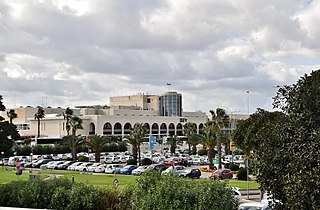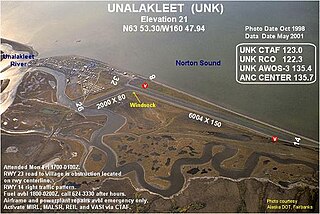Related Research Articles

Palm Beach International Airport is a public airport in Palm Beach County, Florida, located just west of the city of West Palm Beach, Florida, United States, for which it serves as the primary airport. It is also the primary airport for most of Palm Beach County, serving the suburbs and cities of Boca Raton, Wellington, Boynton Beach, Jupiter, and Palm Beach Gardens. It is the third busiest airport in the Miami metropolitan area after Miami International Airport and Fort Lauderdale–Hollywood International Airport. The airport is operated by Palm Beach County's Department of Airports. Road access to the airport is direct from I-95, Southern Boulevard, and Congress Avenue. The airport is bordered on the west by Military Trail.

Novosibirsk Tolmachevo Airport is situated in the town of Ob, 16 kilometres (9.9 mi) west of the center of Novosibirsk, an industrial and scientific center in Siberia and Russia's third-largest city.
Uyo is the capital city of Akwa Ibom, a state in South South Nigeria.

Malta International Airport is the only airport in Malta, and it serves the whole of the Maltese Islands. It is located on the island of Malta, southwest of the Maltese capital, Valletta, in the town of Luqa, and occupies the location of the former RAF Luqa. The airport serves as the main hub for KM Malta Airlines and Medavia besides being an operating base for Ryanair and its subsidiary Malta Air. It is also home to the Area Control Center and hosts the annual Malta Airshow. The airport is operated by Malta International Airport plc.

Iqaluit Airport serves Iqaluit, Nunavut, Canada and is located adjacent to the city. It hosts scheduled passenger service from Ottawa, Montreal, Rankin Inlet, and Kuujjuaq on carriers such as Canadian North, and from smaller communities throughout eastern Nunavut. It is also used as a forward operating base by the Royal Canadian Air Force (RCAF). In 2011, the terminal handled more than 120,000 passengers.
Yenagoa is a Local Government Area and capital city of Bayelsa State, Southern Nigeria. It is located at the Niger-Delta region of the country at coordinates 4°55′29″N6°15′51″E.

Buckland Airport is a state-owned public-use airport located one nautical mile (1.85 km) southwest of the central business district of Buckland, a city in the Northwest Arctic Borough of the U.S. state of Alaska. The airport is situated on the Buckland River.

Emmonak Airport is a state-owned public-use airport located in Emmonak, a city in the Kusilvak Census Area of the U.S. state of Alaska.

Iliamna Airport is a state-owned public-use airport located three nautical miles (5.5 km) west of the central business district of Iliamna, in the Lake and Peninsula Borough of the U.S. state of Alaska.

Unalakleet Airport is a state-owned public-use airport located one nautical mile (2 km) north of the central business district of Unalakleet, a city in the Nome Census Area of the U.S. state of Alaska.
Nuiqsut Airport is a public use airport located in Nuiqsut, a city in the North Slope Borough of the U.S. state of Alaska. It is owned by North Slope Borough.

Hetian Kungang Airport is an airport serving Hotan, a city in the autonomous region of Xinjiang in China.

Hang Nadim International Airport is an international airport located in Batam, Riau Islands, Indonesia. It is named after Laksamana Hang Nadim Pahlawan Kechik, a legendary Malay warrior from the region. The airport is the primary method of transport to and from Batam, alongside ferries to neighboring islands, including the sovereign city-state of Singapore in the north.

Grozny Airport is an international airport in Chechen Republic, Russia located 7.5 km north of Grozny.

Manokotak Airport is a state-owned public-use airport located one mile (2 km) north of the central business district of Manokotak, a city in the Dillingham Census Area of the U.S. state of Alaska.

Deering Airport is a state-owned public-use airport located two nautical miles (3.7 km) southwest of the central business district of Deering, a city in the Northwest Arctic Borough of the U.S. state of Alaska.
Koyuk Alfred Adams Airport is a state-owned public-use airport located in Koyuk, a city in the Nome Census Area of the U.S. state of Alaska.

Toksook Bay Airport is a state-owned public-use airport located one nautical mile (1.8 km) east of the central business district of Toksook Bay, a city in the Bethel Census Area of the U.S. state of Alaska.
Efogi Airport is an airfield serving Efogi, in the Central Province of Papua New Guinea.

Chinggis Khaan International Airport, also referred to as New Ulaanbaatar International Airport, is the primary airport serving Ulaanbaatar, and is Mongolia's only international airport. It opened on 4 July 2021, replacing Buyant-Ukhaa International Airport.
References
- ↑ "Efogi weather forecast for today". JustWeather.com. Retrieved 2024-11-07.
- ↑ "Efogi Airport (EFG)". World Airport Codes. Retrieved 2024-11-07.